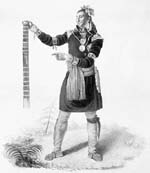
![[graphic]](91/h3-vtb51.jpg)









![[graphic]](91/h3-vtb00.jpg)
|

|
First Nations and Inuit
Fur Trade
First Nations and Inuit were also important partners in the fur trade. Many made their living by hunting, trapping, carrying the fur to the forts and negotiating the trade. Others helped run the fur-trading posts and made the furs ready to send to Europe.
Made-Beavers
At Hudson's Bay Company forts, tokens called Made-Beavers were given in exchange for furs. One Made-Beaver was given for one perfect beaver pelt. Other types of furs were compared to beaver pelts. At Fort George, 14 Made-Beavers would buy a gun, six would buy a blanket. There were many items to choose from such as hatchets, chisels, knives, files, kettles, beads and tobacco.
Owens, Ann-Maureen and Jane Yealland. Forts of Canada. Toronto: Kids Can Press, ©1996, p. 48.
 | Nicholas Vincent Isawanhonhi, principal Christian chief and captain of the Hurons established at La Jeune Lorette near Québec
Copyright/Source |
Let the Trading Begin!
In June or July, Native people would arrive at the forts with furs. Ceremonies were performed. The chief was given a red coat with brass buttons to show he was important. Speeches were made, the peace pipe was smoked, followed by a party and feast. The next morning the trading would begin.
Owens, Ann-Maureen and Jane Yealland. Forts of Canada. Toronto: Kids Can Press, ©1996, p. 48.
|
